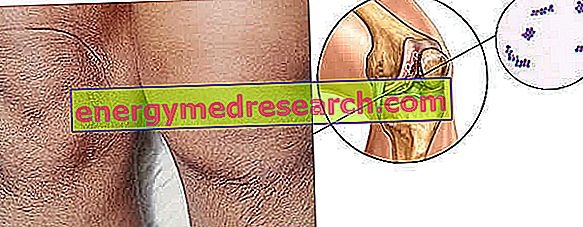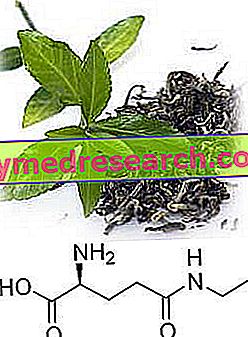Generality
What is phenylalanine?
Phenylalanine is an amino acid contained in most animal and plant proteins.

Considering the inability to synthesize it from other amino acids, phenylalanine is considered an essential amino acid for the human organism.
Curiosity: History of Phenylalanine
The first description of phenylalanine was made in 1879, when Schulze and Barbieri identified a compound of empirical formula C 9 H 11 NO 2 in the seeds of yellow lupine (botanical name Lupinus luteus ).
In 1882 Erlenmeyer and Lipp synthesized phenylalanine from phenylacetaldehyde, hydrogen cyanide and ammonia.
The genetic codon for phenylalanine was instead discovered by J. Heinrich Matthaei and Marshall W. Nirenberg in 1961, establishing the coding relationship between information stored in genomic nucleic acids with cell protein expression.
Functions
Phenylalanine: what is it for?
The L- form of phenylalanine is commonly used as a "structural brick" of human proteins. It is therefore essential for the synthesis of any type of peptide, not only plastic, but also enzymatic, hormonal, etc. It also serves as a precursor for:
- Amino acid tyrosine, thanks to which the biosynthesis of:
- Thyroid hormones: mediators of the thyroid gland that regulate the cellular metabolism of the whole organism.
- L-DOPA (levodopa): intermediate amino acid in the biosynthesis of dopamine.
- Dopamine is a catecholamine-type neurotransmitter, necessary for brain metabolism; it is deficient in people with Parkinson's disease. It is also indispensable for the production of noradrenaline.
- Norepinephrine (or norepinephrine) is an important catecholamine-type neurotransmitter of the sympathetic nervous system; it is therefore one of the "stress hormones" from which adrenaline can be derived.
- Adrenaline (or epinephrine) is the main catecholamine-type neurotransmitter of the sympathetic nervous system (another stress hormone).
- 2-phenylethylamine (phenylethylamine): alkaloid neurotransmitter; it is also found in fermented foods, such as cheese, and in chocolate. It seems to play a fundamental role in falling in love.
- Melanin (the pigment of the skin).
Phenylalanine in plants: precursor of flavonoids
Phenylalanine is the starting compound used in the synthesis of flavonoids. Even lignans, non flavonoid polyphenols, derive from phenylalanine (but also from tyrosine).
Phenylalanine is converted into cinnamic acid by the ammonium phenylalanine enzyme; this white colored acid, with its typically bitter taste, is instead endowed with a pleasant aroma (honey and flowers) used in cosmetics. Cinnamate can also be obtained from cinnamic acid, a compound used in pharmacology to produce anthelmintic drugs (which eliminate some worm infestations).
Food
Phenylalanine in foods

Additives and integraters
Phenylalanine in aspartame
This amino acid is also present in aspartame, a substance of protein nature (precisely it is a dipeptide consisting of aspartic acid and phenylalanine esterified with methanol at the carboxyl end) with a sweetening power about 200 times higher than that of sugar.
For this reason, those suffering from phenylketonuria (see below) should be very careful to avoid products sweetened with aspartame, especially soft drinks. To warn these individuals of the risk deriving from their consumption, the words " contains a source of phenylalanine " appear on the labels of many beverages.
Regardless of this characteristic, in recent times, in the wake of studies that for decades have continued to question food safety, especially for children, the use of aspartame has been significantly reduced.
Phenylalanine supplements
Thanks to its function as a hormonal precursor - neurotransmitter, phenylalanine is also used in the formulation of analgesic and antidepressant supplements.
Excess
Excess phenylalanine in healthy people
Phenylalanine can accumulate to create a significant pathological picture in the genetic pathology called phenylketonuria (see below); on the other hand, if in excess, it can also be harmful in healthy people.
Phenylalanine uses the same active transport channel as the amino acid tryptophan, which is necessary to cross the blood-brain barrier.
Phenylalanine can interfere in quantities much higher than the norm, which can only be obtained through reckless food integration:
- With the production of serotonin and other aromatic amino acids
- With the production of nitric oxide, due to the excessive commitment (or possibly limited availability) of the associated cofactors, iron and tetrahydrobiopterin.
Note : the corresponding enzymes belong to the L-amino acid-aromatic decarboxylase family of NO synthase.
Phenylketonuria
Phenylalanine and phenylketonuria
Phenylketonuria is a pathological condition on a hereditary basis, due to the inability to metabolize phenylalanine. The body of people affected by this disease is unable to convert this amino acid to tyrosine, which we have seen to be important, among other things, for the synthesis of catecholamines, thyroid hormones and melanin (the pigment responsible for skin color). Melanin deficiency is manifested by generalized skin hypopigmentation. OR
In addition to this aesthetic defect, due to the impossibility of metabolizing it, phenylalanine accumulates in the tissues giving rise to severe skin and neurological disorders.
Production
How is phenylalanine obtained?
L-phenylalanine is produced in large quantities using a bacterium from the group Escherichia coli, which naturally produces various aromatic amino acids such as phenylalanine, especially in its genetically modified form for industrial use.



